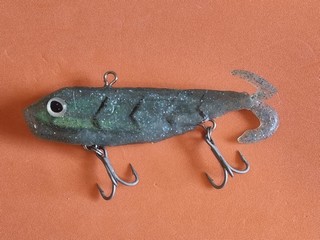Blog
{{start}}
Fishing and fishing related blogs
{{end}}

{{+1}}Masthead reef 20/6/24{{-1}}
{{start}}
Got a text from from my next door neighbor Tom on Wednesday inviting me out to Masthead on Saturday to target our favourite table fish Red Throat Emperor.{{end}}

{{+1}}Fishing, my ongoing passion{{-1}}
{{start}}
My most recent fishing project has been the development of a technique that I call Micro Baiting with Vibes. This is turning out to be an exciting type of fishing and I will detail that in a future post.{{end}}

{{+1}}www.fishonfly.com.au{{-1}}
{{start}}
From 26th September 2024 full access to www.fishonfly.com.au will be free.{{end}}

{{+1}}Recycling a damaged 115mm vibe{{-1}}
{{start}}
OK its not as good looking as the original vibe but it was a great way to keep myself entertained on yet another windy and wet day.{{end}}

{{+1}}We are moving closer to the bream spawning season:{{-1}}
{{start}}
Because I have seen plenty of bream around boat ramps in the last couple of weeks you may want to give a little thought to getting you bream gear ready … I have certainly started doing just that.{{end}}

{{+1}}Calliope River{{-1}}
{{start}}
The Calliope is a big river system and provides a variety of fishing options from very tidal hot water salt water at the power station near the entrance to almost fresh water above the Old Bruce Highway bridge just outside of the town of Calliope.{{end}}
{{+1}}NSW – fishing season reminders{{-1}}
{{start}}
Bass
Zero bag limit for bass and estuary perch starts 1 May and ends 31 August. Catch and release is allowed. The zero bag limit does not apply to fish in stocked freshwater impoundments, including Glenbawn Dam and Glennies Creek Dam in the Hunter Valley, Brogo Dam near Bega and Clarrie Hall and Toonumbar Dams in the northeast; anglers may continue to fish for these species in those waters all year round.
Trout
Spawning season starts 1 May in the Snowy Mountains and special rules apply to the Thredbo River and its tributaries and the Eucumbene River and its tributaries (upstream of the Lake Eucumbene dam wall and including Providence Portal). A minimum size limit of 50 cm, daily bag limit of one and possession limit of two trout will apply to these rivers from 1 May to the end of the Queen’s Birthday long weekend.
Annual closure on fishing in trout streams for NSW will be in place from Tuesday after the Queen's Birthday weekend and re-opens on the October long weekend. Trout dams remain open to fishing throughout the year.
When the season opens again in October, a minimum size limit of 25 cm, daily bag limit of two and possession limit of four trout again applies to the Thredbo and Eucumbene Rivers and other fly and lure only waters in NSW.
Murray cod
Season closed in NSW from 1 September to 31 November, except Copeton Dam.
Eastern Freshwater Cod
The annual three month fishing closure of the Mann and Nymboida Rivers and their tributaries comes into effect 1 August to 31 October. All fishing in the specified area is prohibited to enable the endangered Eastern Freshwater Cod to spawn uninterrupted during its breeding season. Eastern Freshwater Cod are totally protected throughout NSW regardless of where or when they may be found.
Murray crayfish
Closed all year other than the following waters between 1 June and 31 August each year inclusive: (a) Murrumbidgee River between the Hume Highway road bridge, Gundagai and Berembed Weir near Ganmain and (b) Murray River from 130 below Hume Weir near Albury to the Newell Highway road bridge at Tocumwal
{{end}}

{{+1}}NSW – Changes to rigged rods regulations{{-1}}
{{start}}
It's about time ... "Anglers in NSW can now carry additional fishing rods and lines rigged with artificial flies or lures when fishing in non-tidal waters."{{end}}

{{+1}}Lake Awoonga – new hatchery up and running{{-1}}
{{start}}
My sources tell me that 200,00 fry were stocked in May and the intention is to stock 1 million fry by Christmas. Mangrove Jack are also being raised at the hatchery and apparently, we can expect 200,00 fry being released as soon as possible and ongoing releases hopefully giving Lake Awoonga a daytime species to target.{{end}}














